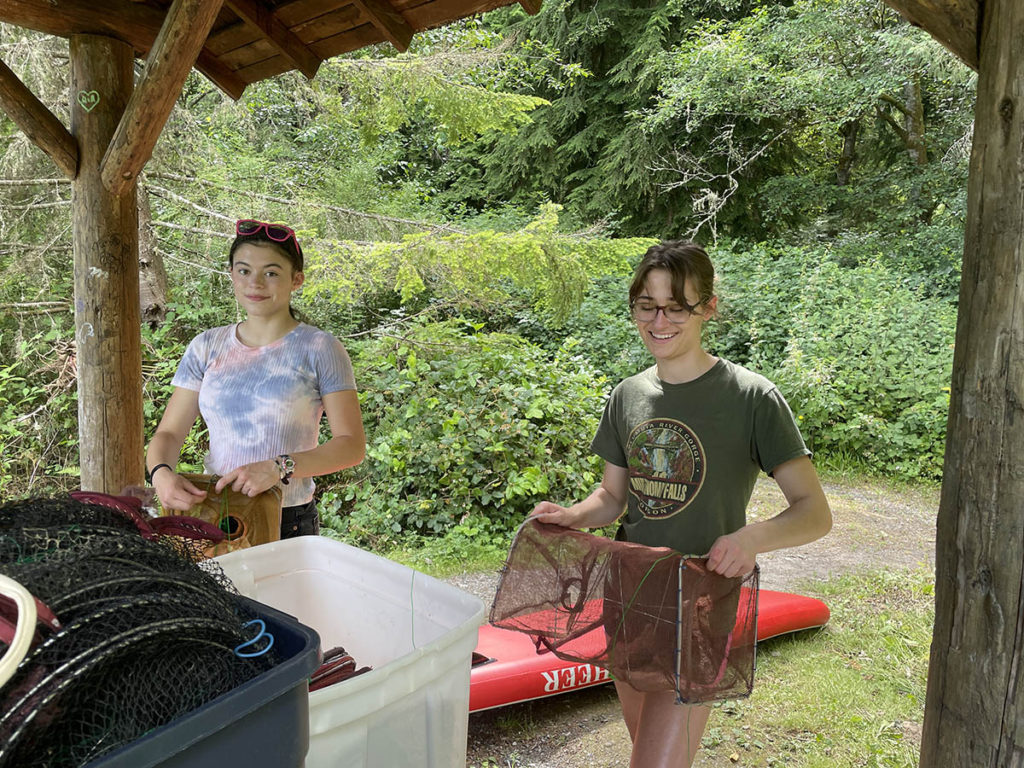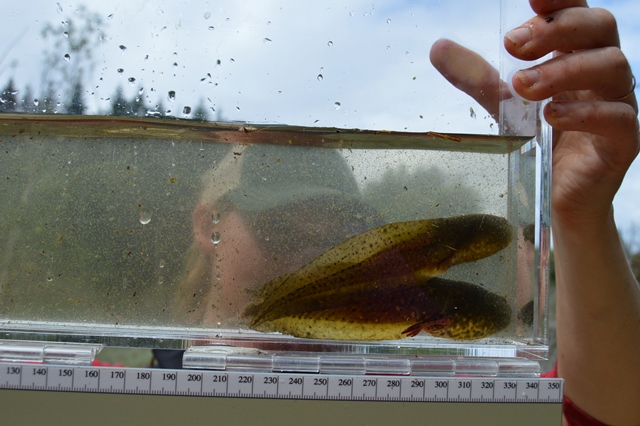This is a special guest blog post by our 2022 Summer Science Communication Intern Alana Bass.
Each year that the Bioblitz survey takes place, residents of Vashon set out to observe and identify every single species that they can – a task that requires a lot of moving parts. As with many BioBlitzes in the past, amphibian traps were set (this year in Johnson and Fisher ponds) and observers searched through nearby forests in order to find different kinds of frogs and salamanders.
On the Friday before the survey began, I – along with intern Amanda Kyles and mentor Maria Metler – helped carry gear to the shelter at Fisher Pond, which is a great access point to the water. There, we put floats in each trap, wrapped them back up, and inflated the paddleboards. (The floats in each trap were to ensure that any amphibians in the traps would have air, as the traps would be placed in water.) We soon realized that the dense growth of lily pads in the pond would make the paddleboards difficult to drag through the water, as the back fin would get caught up in the stems. So naturally, we loaded traps – 15 split between the three of us – onto each paddleboard, all three of which had a detachable back fin.
What began as a simple trip around the pond to set traps turned into a tiring expedition, because a paddleboard without a back fin doesn’t quite move forward, it wiggles side-to-side. On the water, the paddleboards didn’t pick up much momentum, which made the pond suddenly seem much bigger to me, and I wondered how we would ever reach the other side and return in time for me to get to my plans to play soccer later in the afternoon. But we managed to find differing tactics to glide, paddle, and splash through the water. Mine included more impractical methods like stabbing the ground underwater with my paddle and pushing forward; paddling sitting down and facing backwards; and my favorite, laying on my stomach and grabbing lily pads to pull myself ahead. Every few hundred feet, one of us would branch off to the edge of the pond where we would open one of our traps, set it in the water by some aquatic vegetation, and tie it to a branch or log. We would mark that area with a tag labeled with the trap number and the date, and then get to the next site.
About halfway through the paddle, it became obvious to me that I would not in fact be playing soccer afterwards, I would instead be laying on the turf and sunbathing in a haze of mild exhaustion. We eventually finished setting traps in Fisher pond, but when we got back to the shelter and packed up our gear, we still had five traps to set in Johnson Pond (which is part of the Fisher Pond preserve) a few minutes away. We drove over in separate vehicles, and I switched my crocs out for a pair of too-big rubber boots from Maria’s truck, and it only took ten minutes to battle the brambles and wade through the mud to find spots for the last of the traps. While Maria supervised, Amanda and I again opened, tied up, and labeled the traps, and just like that, we were done for the day. Even though the journey around the perimeter of Fisher Pond was an unexpected workout, I was happy to spend the time outdoors on that sunny day, and I was excited to see what kinds of critters we would encounter the next day when I returned to Fisher Pond for the Bioblitz.

I was not part of the group that pulled the traps from the water, so when I arrived at the pond the next day to help at a station for the family walk we organized, I asked about what kinds of amphibians we caught, assuming I’d hear a list of salamanders and frogs. But despite the 20 traps that we set between the two ponds and past Bioblitzes recorded abundances, only two amphibian species were observed as a result of the traps; the California red-legged frog and the American bullfrog. At another point in the Bioblitz, two other people observed a Pacific tree frog and another American bullfrog, bringing the amphibian species count up to 3 this year. The station I had been assigned to for the family walk was the amphibian one, so I was pretty surprised to hear that we had only two amphibians to show people. On top of that, somewhere in between its trap and the shelter at the pond, the red-legged frog made an exit back into the pond, leaving us with a single massive bullfrog tadpole for the station.
In comparison to past Bioblitz results, finding only three species was a surprise. In other ponds (including Fisher) that had been included in Bioblitz and other amphibian studies in the past, a much larger abundance of them were observed, posing the question of, “why did Fisher pond contain so few amphibians?” Considering that everything from the amount of time the traps were left in the ponds to the placement of the traps followed the same protocol as in years prior, there are three potential reasons we came up with as to why this year’s surveys in Fisher pond lacked so many amphibians: invasive bullfrogs, invasive fish species, and the weather.
In Fisher Pond (and all over the island) there are a large number of American bullfrogs, which are native to the Eastern United States, and were introduced to Washington state. They are invasive, and they can grow to a great size in Fisher Pond reaching 6 inches as tadpoles and weighing 2-3 pounds as adults. During their development they stay as tadpoles for a year or two, feeding on anything they can find–including other amphibian eggs. In past years of observation,. Considering Fisher Pond’s well-recognized bullfrog population and its seemingly much smaller populations of other amphibians, it’s entirely possible that there were only a few native amphibians observed this year because many of them were eaten. Bullfrogs also create a lot of competition for the native species of amphibians in the pond, occupying the amphibians’ natural habitat and shelter as well as eating much of their food. Overall, these bullfrogs–at whatever age– can be pretty damaging to the amphibian populations of the pond.

Bullfrogs aren’t the only invasive species inhabiting the pond however – the piscine golden shiner is another notable prospect. Once again, this species is native to the eastern side of the country and seems to be perfectly capable of chowing down on the young salamanders and frogs of Fisher Pond. During another Bioblitz, when surveyed, Christensen Pond held no fish, but instead had flourishing populations of all amphibians (bullfrogs included), showing that maybe bullfrogs are not to blame, but instead the fish. This year’s Bioblitz found huge numbers of these golden shiners, further supporting the hypothesis that they could be responsible for this decline in biodiversity. This isn’t the first time fish have been found in ponds that also had low amphibian presence on Vashon; in 2018, Matsuda pond was home to a very large bass that may have been a voracious amphibian eater. There were no amphibians found in any Bioblitz traps, just that bass! With facts to support both the bullfrogs’ and the shiners’ culpability, it’s hard to know the true reason behind the mystery. If the cause is indeed predation and competition, it’s likely that both these animals are responsible together for the disappearance of so many amphibians.
However, there may be another explanation for this disappearance that has nothing to do with these invasive species. This winter and spring were very cold and wet, which is not the typical weather pattern during their migration and breeding seasons in and out of ponds. Since the weather this year was a bit unusual, the amphibians may have just left the pond and returned to the forest early, or changed their life cycle timing in some way that shifted their presence in ponds to be out of sync with our trapping efforts. It’s entirely possible that the amphibian populations left the Bioblitz observers with no data simply because they migrated earlier in the year than what was normal. If this is the case, it could carry implications for climate change impacts to amphibians if our seasonal weather patterns continue to stray from long-time averages.
This year’s Bioblitz results open doors for investigation on the matter, with all the potential causes that should be looked into before taking action. Native species biodiversity is important, and with the possibility of multiple invasive species creating a disruption, it’s important that we fully understand this change so that we can help steer things back to a better equilibrium. As the seasons change, amphibian populations will be monitored in Fisher pond along with its forests to see if the climate is the factor that caused the results. Golden shiner and American bullfrog numbers will be watched as well in comparison to amphibian numbers, and with that data, definitive action can be taken. The amphibians are important to Fisher Pond’s ecosystem, so it’s vital that this issue is sorted out before the situation becomes dire. Just remember – it takes an entire community to get to the bottom of a mystery.

Thanks for this story, Amanda! It is really interesting that this year Mukai Pond (not too far away from Fisher Pond as the crow flies) had a huge bullfrog tadpole population and successful N. Pacific tree frog and red-legged populations. The bullfrog tadpoles die off because the pond is seasonal (they need two years to develop), but they were present when the other frogs were developing. I appreciated reading your report.